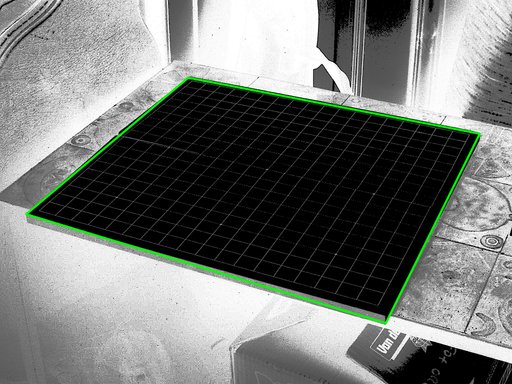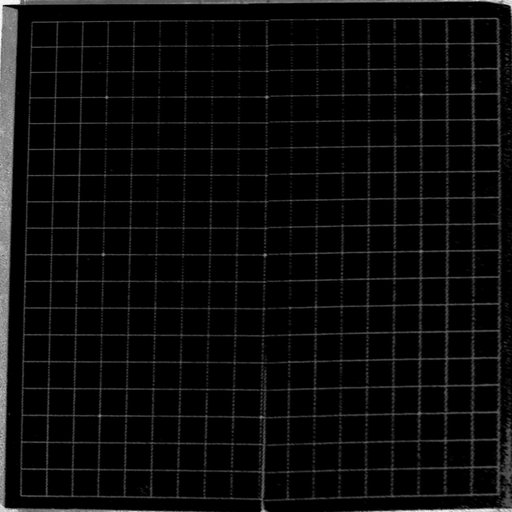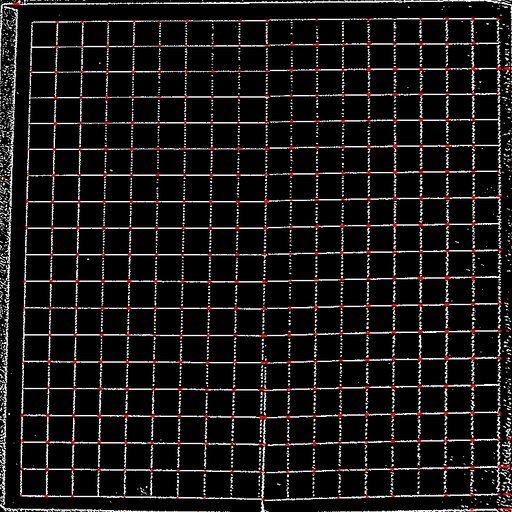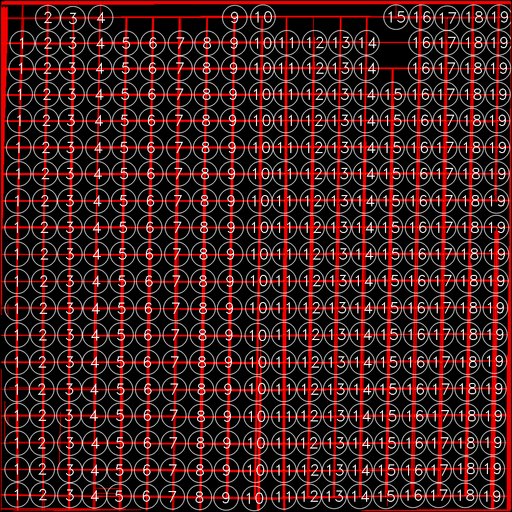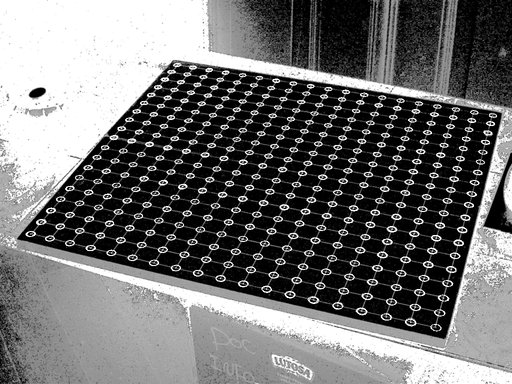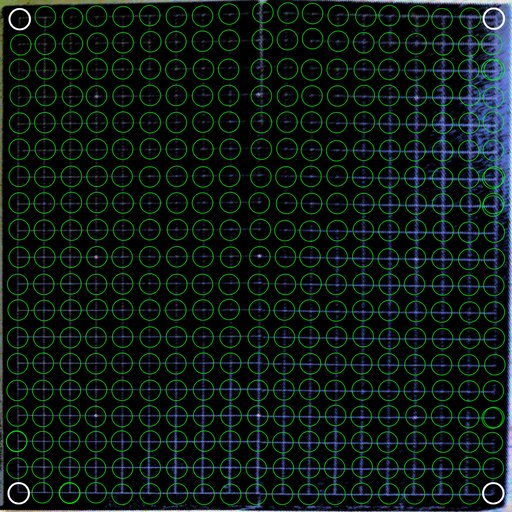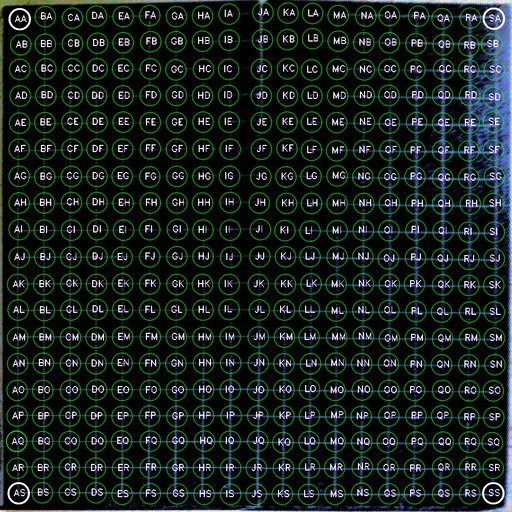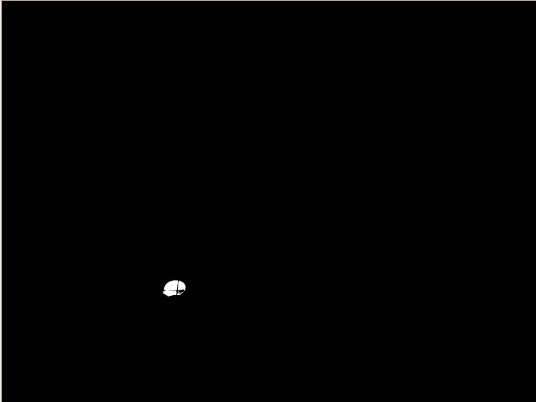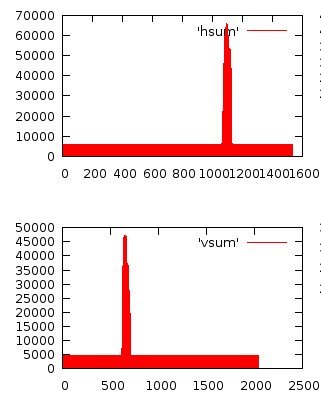Difference between revisions of "Kifu: Go game record (kifu) generator"
| (19 intermediate revisions by the same user not shown) | |||
| Line 1: | Line 1: | ||
| − | ''' | + | '''Goban and Grid Detection:''' |
| + | |||
| + | 1. The input image is filtered and thresholded and a big quadrilateral shape is selected, sorting contours detected with cvFindContours() from OpenCV. | ||
| − | + | [[Image:kifu_region.jpg]] | |
| − | |||
| + | 2. The selection can be rectified with cvGetPerspectiveTransform() and cvWarpPerspective() but using a specific procedure allow to save the original coordinates in a table at the cost of a few megabytes of ram. It should be also more performant, avoiding some unused features overhead. | ||
| − | + | [[Image:kifu_rectify.jpg]] | |
| − | |||
| − | + | 3. cvHoughLines2() find lines in the rectified selection and we compute the intersections for each detected line segment. | |
| − | + | [[Image:kifu_intersections.jpg]] | |
| − | |||
| − | + | 4. The intersection is first validated when the angle formed by the intersection point and the line extremities is near 90 degrees; and other detected intersections that are less distant than ~92% of the expected grid spacing are discarded. Finally each 'cell' or group is validated when the 2 opposite corners are around 90 degrees. | |
| − | + | [[Image:kifu_intersections2.jpg]] | |
| − | |||
| + | 5. Intersections can be mapped back to the pre-warped coordinates and vote for the original point, and we restart at step 2 with the quadrilateral found with the next threshold value. | ||
| − | + | [[Image:kifu_backproj.jpg]] | |
| − | + | 6. Assuming extreme intersection coordinates in the original image are the corners, the transformation matrix is recomputed using those "corners" and intersections are mapped into this plane. | |
| − | + | [[Image:kifu_rectify2.jpg]] | |
| − | + | 7. Numbering is made line per line, starting from the top left corner, looking for the nearest neighbour on the right of the current position, up to the end of line. The next line is found looking for the nearest neighbour below the line start, etc | |
| + | [[Image:kifu_numbering.jpg]] | ||
| − | + | 8. Finally, we can validate the grid simply by checking the count of numbered intersections, or restart at step 1 with another threshold and look for missing ones. | |
| − | |||
| − | |||
| − | |||
| − | |||
| − | |||
| − | |||
| − | + | '''Image change detection:''' | |
| − | + | Using vertical and horizontal RGB components sums of a thresholded difference between a reference image and the current one, | |
| − | |||
| − | |||
| + | it is easy to compute the image coordinates of a played stone | ||
| − | + | [[Image:kifu_threshold.jpg]] [[Image:kifu_sums.jpg]] | |
| − | |||
| Line 59: | Line 52: | ||
When a stone is played it overlaps 1 grid square on a corner, 2 on the borders and 4 in the center. | When a stone is played it overlaps 1 grid square on a corner, 2 on the borders and 4 in the center. | ||
| − | Computing horizontal and vertical pixel sums for each grid cell can tell | + | Computing horizontal and vertical pixel sums for each grid cell or around each intersection |
| + | can tell where the stone is played and reveal the color of the stone, | ||
| + | being darker or brighter than the empty intersection region. | ||
| − | the stone is | + | The intersection can also be seen on the difference image when the stone is white, |
| + | that could also be used to detect the stone color. | ||
| Line 68: | Line 64: | ||
'''Methods for mapping the coordinates:''' | '''Methods for mapping the coordinates:''' | ||
| + | |||
"2.2 Perspective transformation with two vanishing points" | "2.2 Perspective transformation with two vanishing points" | ||
| Line 92: | Line 89: | ||
'''Links:''' | '''Links:''' | ||
| + | |||
irc://irc.freenode.net/#kifu | irc://irc.freenode.net/#kifu | ||
| + | |||
http://www.sourceforge.net/projects/kifu | http://www.sourceforge.net/projects/kifu | ||
| + | |||
| + | |||
| + | http://opencvlibrary.sourceforge.net/ | ||
| + | |||
Photointerpretation and Small Scale Stereoplotting with Digitally Rectified Photographs with Geometrical constraints: | Photointerpretation and Small Scale Stereoplotting with Digitally Rectified Photographs with Geometrical constraints: | ||
http://cipa.icomos.org/fileadmin/papers/potsdam/2001-21-gf01a.pdf | http://cipa.icomos.org/fileadmin/papers/potsdam/2001-21-gf01a.pdf | ||
| + | |||
Vision par Ordinateur: | Vision par Ordinateur: | ||
http://www-prima.imag.fr/jlc/Courses/2002/DEA-IVR.VO/DEA-IVR.VO.S2.pdf | http://www-prima.imag.fr/jlc/Courses/2002/DEA-IVR.VO/DEA-IVR.VO.S2.pdf | ||
| + | |||
Projective Mappings for Image Warping: | Projective Mappings for Image Warping: | ||
http://citeseerx.ist.psu.edu/viewdoc/summary?doi=10.1.1.9.7803 | http://citeseerx.ist.psu.edu/viewdoc/summary?doi=10.1.1.9.7803 | ||
| + | |||
http://sciences.ch/htmlfr/geometrie/geometrieprojective01.php | http://sciences.ch/htmlfr/geometrie/geometrieprojective01.php | ||
Latest revision as of 03:44, 30 June 2009
Goban and Grid Detection:
1. The input image is filtered and thresholded and a big quadrilateral shape is selected, sorting contours detected with cvFindContours() from OpenCV.
2. The selection can be rectified with cvGetPerspectiveTransform() and cvWarpPerspective() but using a specific procedure allow to save the original coordinates in a table at the cost of a few megabytes of ram. It should be also more performant, avoiding some unused features overhead.
3. cvHoughLines2() find lines in the rectified selection and we compute the intersections for each detected line segment.
4. The intersection is first validated when the angle formed by the intersection point and the line extremities is near 90 degrees; and other detected intersections that are less distant than ~92% of the expected grid spacing are discarded. Finally each 'cell' or group is validated when the 2 opposite corners are around 90 degrees.
5. Intersections can be mapped back to the pre-warped coordinates and vote for the original point, and we restart at step 2 with the quadrilateral found with the next threshold value.
6. Assuming extreme intersection coordinates in the original image are the corners, the transformation matrix is recomputed using those "corners" and intersections are mapped into this plane.
7. Numbering is made line per line, starting from the top left corner, looking for the nearest neighbour on the right of the current position, up to the end of line. The next line is found looking for the nearest neighbour below the line start, etc
8. Finally, we can validate the grid simply by checking the count of numbered intersections, or restart at step 1 with another threshold and look for missing ones.
Image change detection:
Using vertical and horizontal RGB components sums of a thresholded difference between a reference image and the current one,
it is easy to compute the image coordinates of a played stone
Stone detection:
When a stone is played it overlaps 1 grid square on a corner, 2 on the borders and 4 in the center.
Computing horizontal and vertical pixel sums for each grid cell or around each intersection can tell where the stone is played and reveal the color of the stone, being darker or brighter than the empty intersection region.
The intersection can also be seen on the difference image when the stone is white, that could also be used to detect the stone color.
Methods for mapping the coordinates:
"2.2 Perspective transformation with two vanishing points"
(pages 2 and 3, equations 7 and 10)
http://cipa.icomos.org/fileadmin/papers/potsdam/2001-21-gf01a.pdf
Inverse homography and plane image rectification (page 14)
http://www-prima.imag.fr/jlc/Courses/2002/DEA-IVR.VO/DEA-IVR.VO.S2.pdf
"Inferring Projective Mappings" (page 3)
http://citeseerx.ist.psu.edu/viewdoc/summary?doi=10.1.1.9.7803
with related java and C source code here: http://www.developpez.net/forums/showthread.php?t=591698
Links:
http://www.sourceforge.net/projects/kifu
http://opencvlibrary.sourceforge.net/
Photointerpretation and Small Scale Stereoplotting with Digitally Rectified Photographs with Geometrical constraints:
http://cipa.icomos.org/fileadmin/papers/potsdam/2001-21-gf01a.pdf
Vision par Ordinateur:
http://www-prima.imag.fr/jlc/Courses/2002/DEA-IVR.VO/DEA-IVR.VO.S2.pdf
Projective Mappings for Image Warping:
http://citeseerx.ist.psu.edu/viewdoc/summary?doi=10.1.1.9.7803
http://sciences.ch/htmlfr/geometrie/geometrieprojective01.php
